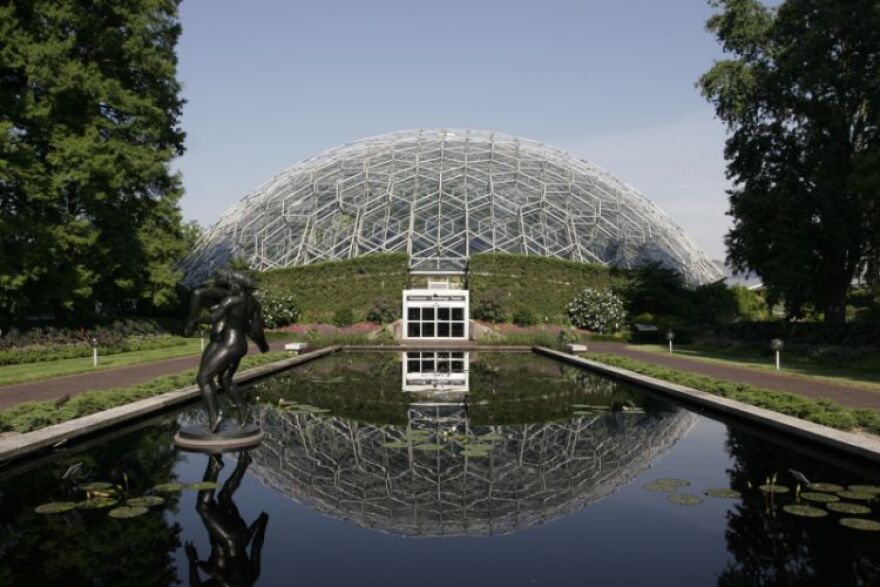By Catherine Wolf, KWMU
http://stream.publicbroadcasting.net/production/mp3/kwmu/local-kwmu-842959.mp3
St. Louis, MO –
The Missouri Botanical Garden is celebrating its 150th anniversary on June 15. Under the guidance of President Peter Raven, it has grown to be one of the top botanical gardens in the world, according to industry leaders. That's despite facing some challenges along the way.
On a recent warm, spring day visitors strolled through rows of roses, irises and other colorful displays. Some have been coming to the Garden for years, like native St. Louisans Janet Burns and Regina Orf.
"We always like the Japanese Garden. We make a point of going through that every time. We stop at the Kemper Center and we talk to them quite frequently about what we want to do at the house."
Four-year-old Becca was there for her first visit with grandmother Barbara Berkmeyer. Berkmeyer asked her granddaughter what she liked best about the garden.
"I like flowers, I like flowers the best."
 Creator Henry Shaw likely would have been pleased to see residents still enjoying his garden. He built it in 1859 as a gift to the city where he earned his fortune. Inspired by the gardens of Europe, Shaw wanted to create both a pleasure garden and research facility. He acquired the first of more than six million plant specimens for the garden's herbarium and purchased botanical books to build its library. Current President Peter Raven said the grounds also quickly became a popular relaxation destination.
Creator Henry Shaw likely would have been pleased to see residents still enjoying his garden. He built it in 1859 as a gift to the city where he earned his fortune. Inspired by the gardens of Europe, Shaw wanted to create both a pleasure garden and research facility. He acquired the first of more than six million plant specimens for the garden's herbarium and purchased botanical books to build its library. Current President Peter Raven said the grounds also quickly became a popular relaxation destination.
"Very large numbers of people visited here because you didn't have the equivalent of jumping into an automobile and driving to Lake of the Ozarks or something."
 Times weren't always bright for Shaw's Garden. It took a financial hit during the Great Depression that limited development and upkeep of displays. By the 1950s, attendance had dropped to an all-time low. Raven said opening the dome-shaped climatron in 1960 helped the garden regain visitors and income.
Times weren't always bright for Shaw's Garden. It took a financial hit during the Great Depression that limited development and upkeep of displays. By the 1950s, attendance had dropped to an all-time low. Raven said opening the dome-shaped climatron in 1960 helped the garden regain visitors and income.
"The only larger geodesic dome at the time was in Baton Rouge. When the climatron was built it received national publicity. It's so spectacular and beautiful."
Raven has been the garden's longest and most influential leader. He took the reigns in 1971 and he created his own so-called master plan for expansion. It included creating multiple new gardens and increasing research.
The garden now has scientists in 36 countries collecting and identifying plant species. Workers at the facility's William L. Brown Center use those specimens to identify plant compounds that can be used to make medicines. Rainer Bussmann is the center's director. He said there are more than 350,000 plants in the world, but only 1 percent have been identified for their medicinal uses.
"We might not even know a lot of these plants because they grow in remote areas. They have never described scientifically. No researcher has looked at them, and they might disappear before we know them."
In addition to identifying plant species, the garden educates people in countries like Madagascar and Peru to garden sustainably. It also trains college students in botany.
 Expansions have gone well under Raven's leadership. The garden has grown from less than 100 employees to more than 500, and it now covers 79 acres. But it has also received some criticism in recent years. It supported the conversion of McRee Town, a surrounding neighborhood, to Botanical Heights. Some residents were upset at being relocated as buildings were demolished. Raven says the changes were necessary because the neighborhood had become run down.
Expansions have gone well under Raven's leadership. The garden has grown from less than 100 employees to more than 500, and it now covers 79 acres. But it has also received some criticism in recent years. It supported the conversion of McRee Town, a surrounding neighborhood, to Botanical Heights. Some residents were upset at being relocated as buildings were demolished. Raven says the changes were necessary because the neighborhood had become run down.
"One of the worst areas in the city for crime, crackhouses, lead paint, low birth weight. It really did need to be addressed."
No agency accredits botanical gardens. However, the American Public Gardens Association provides guidelines for establishing them. Dan Stark is the association's director. He said the Missouri Botanical Garden has risen to the forefront internationally because it's stayed true to Shaw's emphasis on plant science.
"They've been able to attract some very effective leaders and through that have been able to raise the prominence of the institution as an importance research institution within the horticulture world."
The garden is now facing its next big challenge as Raven is making plans to retire within the next few years. Garden officials reportedly have begun an extensive search process for his replacement.

